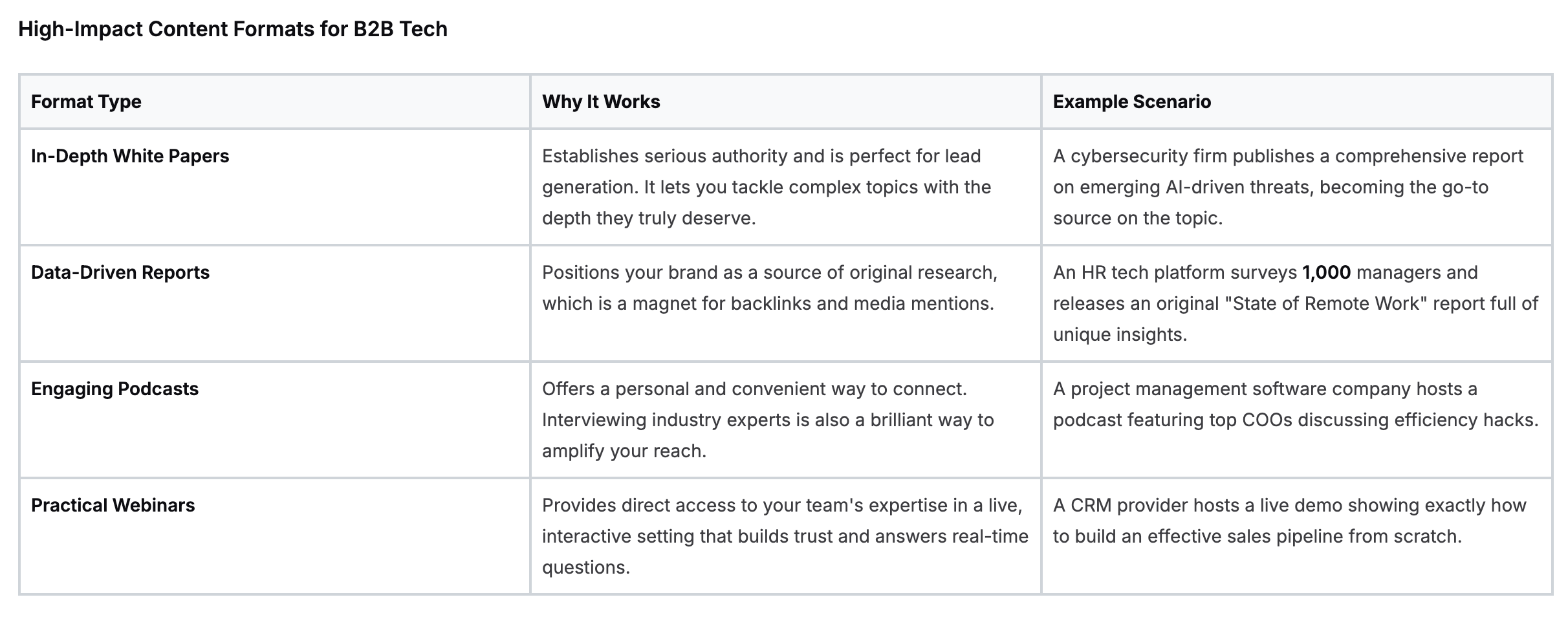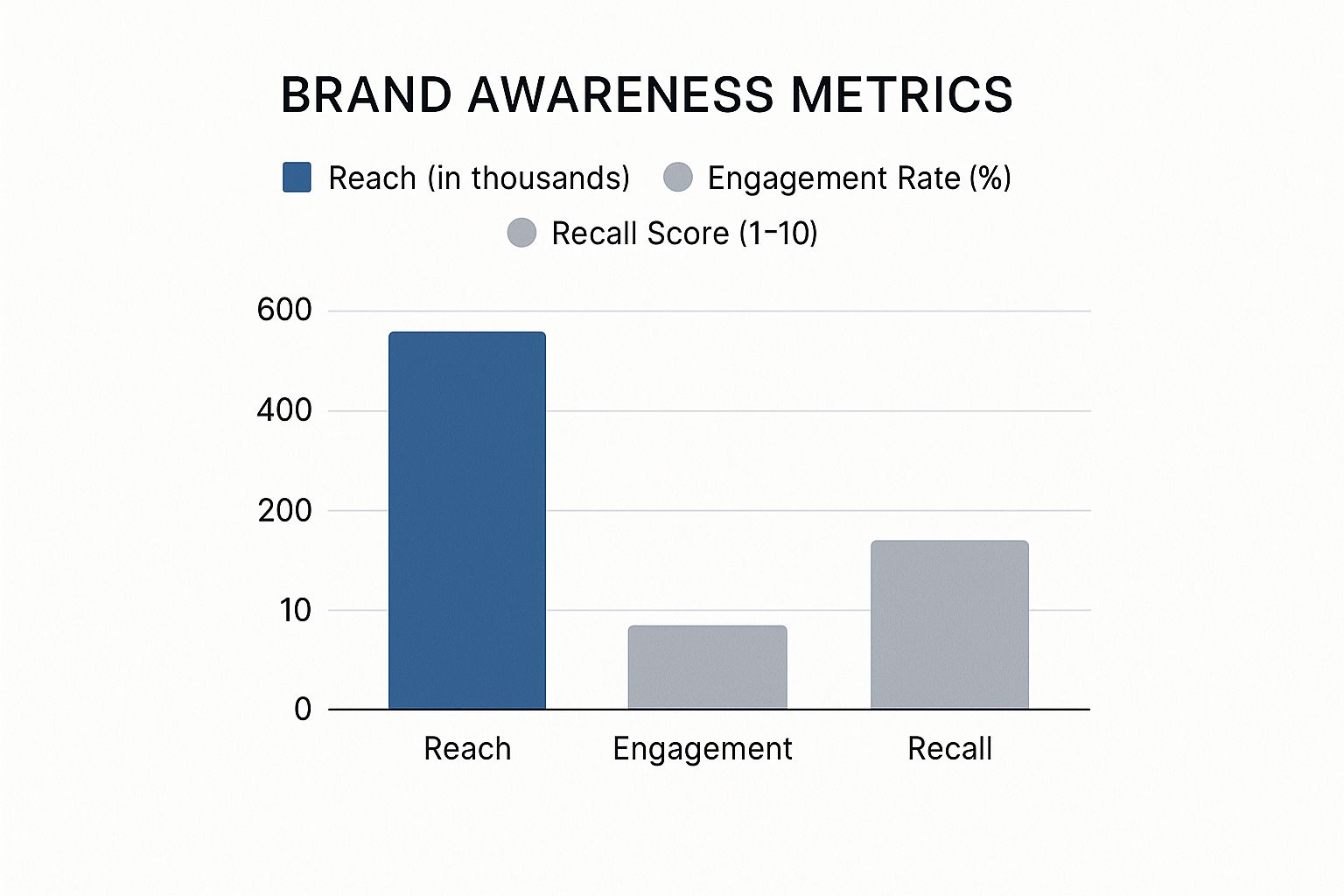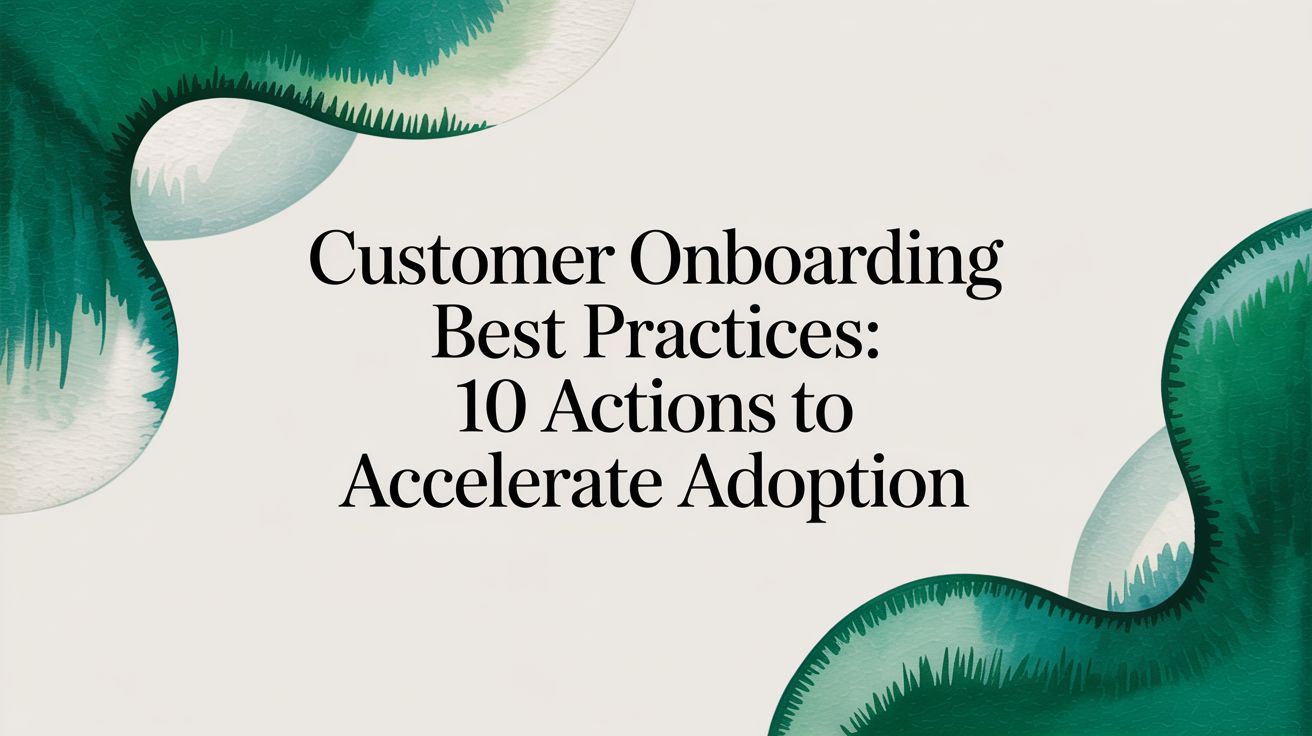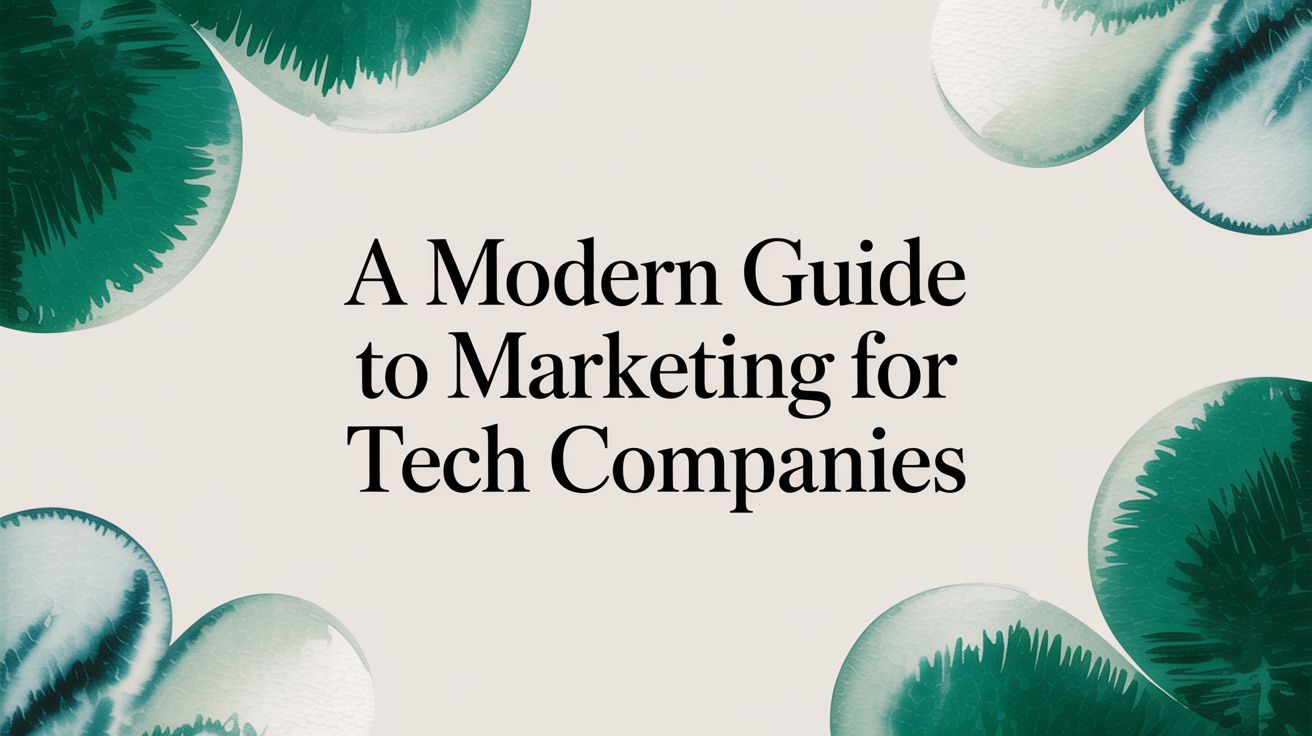How to Build Brand Awareness That Lasts
August 6, 2025

Building brand awareness isn't just about getting your name out there. It's about creating a memorable, trusted presence that connects with your ideal customers long before they're ready to buy. When done right, your brand is what people recognize, remember, and ultimately choose. The best in the business pull this off through consistent messaging, genuinely valuable content, and authentic engagement where it matters most.
Why Brand Awareness Is Your Unseen Growth Engine

Let's cut through the marketing jargon. Brand awareness is the invisible force that drives sustainable growth, especially for B2B tech and SaaS companies. Think of it as the bedrock of trust that makes every single one of your other marketing and sales efforts more effective.
It's simple, really. When people already know and respect your brand, sales cycles get shorter. Prospects don't come in cold; they enter the conversation with a baseline of trust, which smooths out the friction points and speeds up decisions. It's the difference between a cold call and a warm handshake.
The Financial Impact of a Strong Brand
A powerful brand isn't just a "nice-to-have" marketing asset. It translates directly into hard financial value and market resilience. It acts as a moat around your business, making you far less vulnerable to price wars and the constant threat of new competitors.
This isn't just a theory; it's reflected on a global scale. In 2025, the world's top 500 brands hit a combined value of nearly $9.5 trillion. That’s a massive 10% jump from the previous year, proving their strength even when the broader economy was sluggish. You can see the full breakdown of how top brands protect their value in the Brand Finance Global 500 report.
This value comes from a few key places:
- Premium Pricing Power: When customers see your brand as a leader, they're more willing to pay a premium. Period.
- Reduced Customer Acquisition Costs: A well-known brand naturally attracts interest. This means you aren't so reliant on expensive ad campaigns to get noticed.
- Increased Customer Lifetime Value: Trust is the glue of loyalty. And loyal customers don't just make repeat purchases—they’re the first to try your new offerings because they already believe in you.
Turning Awareness into Your Greatest Asset
Building this kind of influence doesn't happen by accident. It takes a deliberate, focused strategy.
Just look at brands like Slack or Miro. They didn’t just push a product. They built a community and became synonymous with collaboration itself. They pulled this off by consistently delivering value and creating an identity their audience genuinely wanted to be a part of.
Your brand is the sum of every single interaction a customer has with your company. It's the feeling they're left with, the story they tell themselves (and others) about you. Getting this right is your most important job.
The journey from being an unknown startup to an unforgettable brand is powered by a clear plan. To really ramp up your visibility and connect with your audience, exploring strategies for driving engagement and brand awareness with AI content can be a game-changer.
For B2B tech companies, navigating this complex process often demands a specialized perspective. If you're looking for a clear path forward, understanding why your business needs a brand strategy consultant could give you the direction you're missing.
This guide will give you the actionable strategies you need to build a brand that works for you, turning it into your most powerful growth engine.
Crafting a Brand Identity That Sticks

Before you can build brand awareness, you have to know what your brand is. An undefined, generic brand is simply invisible. Getting this right isn't a fluffy, creative exercise—it's the most critical strategic foundation you'll build.
This is where you forge the soul of your company. It’s about digging deep to find what makes you genuinely different and then learning how to talk about it in a way that energizes your team and captivates your audience. A strong identity makes every marketing dollar you spend work that much harder.
Nail Your Unique Value Proposition
Your unique value proposition (UVP) is the beating heart of your brand. It’s a razor-sharp statement explaining the real, tangible results a customer gets from choosing you. A great UVP is specific, focused on a painful problem, and clearly separates you from the noise.
To find yours, start by answering three essential questions:
- Who is your ideal customer? Be ruthless with your focus. Not "SaaS companies," but "Series A fintech startups drowning in messy customer data."
- What critical pain do you solve for them? Forget surface-level features. What deep, expensive problem are you fixing?
- How do you solve it uniquely? This is your secret sauce. Is it a proprietary algorithm? White-glove onboarding? Unmatched industry expertise?
A weak UVP sounds like a vague promise. A strong one is a powerful guarantee. For example, a B2B cybersecurity firm might go from "We protect your data" to "We stop zero-day threats in under 60 seconds, protecting your enterprise from costly breaches without slowing down your network." See the difference? The second one has teeth.
Find Your Inspiring Mission
While your UVP is about what you do, your mission is about why you do it. A powerful mission gives your team a reason to rally and gives customers a reason to believe in something bigger than your product's feature list. It’s the story that forges an emotional connection.
Think of it this way: your UVP gets you on the shortlist, but your mission gets you chosen. It's the difference between a one-time transaction and a long-term partnership.
A brand with a strong, purpose-driven mission doesn't just sell a product; it leads a movement. It attracts not only customers but also advocates who are eager to be part of its story.
This mission becomes the north star for everything you do—from who you hire to the content you create. It’s the ultimate gut check for making consistent, on-brand decisions. Understanding how to weave this into your marketing is crucial, and you can learn more about how to define and scale your B2B content marketing strategy in our detailed guide.
Establish a Brand Voice That Resonates
Your brand voice is your company's personality in written form. Are you authoritative and academic? Witty and a bit irreverent? Or are you the helpful, empathetic guide? The right voice makes your brand feel human and approachable.
Consistency here is everything. Your voice has to show up the same way, every time, across every touchpoint:
- Website copy
- Social media posts
- Sales emails
- Customer support chats
- Even the microcopy in your product
A classic mistake is defaulting to a stiff, corporate tone that feels totally disconnected from the dynamic, problem-solving reality of a tech startup. Your voice should reflect the culture you're building and connect with the audience you want to attract. For a deeper look at shaping this identity on professional networks, check out these tips on building a personal brand on LinkedIn.
The final step? Document it all. Create a simple, one-page brand guide with your UVP, mission, and voice guidelines. This isn't a 50-page binder that gathers dust on a shelf. It's a living document that your entire team can use to bring your unforgettable identity to life—consistently and powerfully.
Creating Content That Forges Real Connections

Once you've nailed down your brand identity, content becomes the engine that brings your story to life. It’s what turns abstract ideas like "mission" and "value" into tangible assets that actually attract, engage, and inspire the right people.
Let's be honest: in the B2B tech world, your customers are smart, skeptical, and incredibly busy. They don't have time for fluff; they're looking for real solutions. Your content strategy has to go way beyond generic blog posts and aim to create indispensable resources that cement you as a genuine authority. The goal here isn't just to chase clicks—it's to build real connections.
Brainstorming With Purpose
Every great piece of content I've ever seen started by solving a real customer problem. Before you write a single word or hit record, your brainstorming has to be rooted in empathy. It’s a subtle but powerful shift from asking, "What should we post about?" to "What are our customers struggling with right now?"
That change in perspective is huge. It forces you to think from your audience's point of view and create something that delivers immediate value.
A fantastic way to structure this is by mapping out your customer's journey. Pinpoint their key questions and frustrations at each stage, from when they first realize they have a problem to when they're evaluating solutions like yours. Suddenly, you have a deep well of content ideas that are directly tied to what moves the needle for your business.
For example, a B2B SaaS company that automates financial reporting could come up with ideas like:
- Awareness Stage: "The Hidden Costs of Manual Month-End Closing" (A revealing blog post)
- Consideration Stage: "Comparing the Top 5 Financial Automation Tools for Startups" (A gated, high-value white paper)
- Decision Stage: "How Company X Slashed Their Reporting Time by 75% with Our Platform" (A compelling case study video)
This approach makes sure your content isn't just adding to the noise. Instead, it becomes a helpful guide that meets your audience exactly where they are.
Choosing Formats That Command Attention
Not all content formats are created equal, especially when you're trying to reach a savvy B2B audience. While quick social posts have their place, building deep brand awareness and authority usually requires more substantial, high-value formats. These become your "pillar" assets.
Pillar content is the foundational, in-depth work your brand becomes known for. It's the resource your competitors wish they had created and the one your audience bookmarks, shares, and comes back to for months or even years.
You don't have to do everything. The key is to figure out which formats best showcase your expertise and offer the most value to your specific audience, and then do those things exceptionally well.
High-Impact Content Formats for B2B Tech

By focusing on these meatier formats, you move beyond fleeting engagement and start building a library of assets that continuously work to grow your brand awareness and cement your position as a thought leader.
From Creation to Distribution Workflow
Here’s a hard truth: creating great content is only half the battle. Without a solid workflow, even the best ideas die in draft folders or get derailed by missed deadlines. An effective process is what turns your team’s expertise into a consistent, brand-building engine.
Your workflow should be simple, clear, and all about momentum.
- Ideation & Planning: It starts with a shared content calendar built around customer pain points and strategic goals. This is where you assign topics, formats, and deadlines.
- Creation & Review: Get your subject matter experts involved. Let them dump their raw knowledge, and then have a content manager or writer shape it into a polished, on-brand final product.
- Distribution & Amplification: This is the step most companies miss. A single pillar piece can be sliced and diced into dozens of smaller assets—social media posts, email snippets, audiograms, and quote graphics. This is how you maximize the ROI of your initial effort.
- Measurement & Optimization: Finally, track the right metrics. Are people actually downloading the white paper? Are they listening to the full podcast? Use that data to make your next round of content even better.
A structured approach like this turns content creation from a chaotic scramble into a predictable, scalable system for building a brand that people not only follow but are deeply loyal to.
Finding the right channels isn't just about broadcasting your message; it's about finding your audience where they already are—actively looking for solutions, talking with peers, and vetting new technology. You can create the most brilliant content in the world, but if it doesn't reach the right people, it's just noise.
Forget the old "spray and pray" approach of being everywhere at once. Real brand awareness comes from being in the right places, consistently and with purpose.
Today's B2B buyer journey is spread across a ton of different touchpoints. GWI data shows that the average internet user now discovers new brands from 5.8 different sources. This is a huge shift. While search engines still dominate as the top discovery channel at 32.8% globally, it’s crystal clear that a multi-channel strategy isn't just nice to have—it's essential for survival. You can dig into the specifics in this detailed brand discovery report.
So, where do you start? To help you prioritize, here’s a look at the most common channels where consumers are finding new brands.
Top Channels for Brand Discovery
This table highlights the most effective channels where consumers discover new brands, helping you prioritize your marketing efforts.

This data confirms that a blended approach is key. While search is a powerhouse, you can't ignore the influence of social media ads and the undeniable power of good old-fashioned word-of-mouth. It's about building a presence across the channels that matter most to your specific audience.
Master Search to Capture High-Intent Traffic
When a B2B professional hits a wall with a serious problem, what's their first move? They Google it. That's why mastering search engine optimization (SEO) isn't just another marketing task; it's the foundation of your entire brand awareness strategy.
Showing up on that first page means you become part of their solution right from the get-go. Your aim is to be there for the keywords that signal a real, pressing need. Think less about generic, high-volume terms and more about the specific, pain-driven phrases your ideal customer is typing when they’re genuinely stuck.
For example, a SaaS company that builds inventory management software for e-commerce stores should be all over long-tail keywords like "how to reduce stockouts for Shopify" or "best inventory forecasting software for SMBs." Ranking for terms like these does way more than just drive traffic. It immediately positions your brand as an expert resource at the exact moment your audience needs one. It's a critical piece of any solid B2B demand generation plan.
The real magic of SEO for brand building isn't just about the clicks. It's about being the answer. When your content consistently solves problems through search, you build trust and authority at scale, one query at a time.
This chart shows how different awareness metrics—like reach, engagement, and recall—can be tracked to see how your channel strategy is really performing.

It’s a great reminder that a channel with massive reach might not be the best one for driving deep engagement or making your brand memorable. You need a mix.
Use Social And Email To Nurture Awareness
While SEO is fantastic for capturing people actively looking for a solution, social media and email are where you create that demand in the first place. These channels let you stay top-of-mind, build genuine relationships, and nurture awareness over the long haul.
Laser-Focused Social Media
In the B2B tech world, social media isn't about chasing viral trends. It's about delivering targeted value where your buyers hang out professionally. A platform like LinkedIn is gold for this. You can:
- Share high-value content: This is the perfect place to distribute your deep-dive pillar content, like white papers, case studies, and webinar recordings, to a professional audience that actually cares.
- Run targeted ad campaigns: Get hyper-specific with ads aimed at job titles, industries, and company sizes. This way, you know your budget is reaching only the people who can actually buy from you.
- Build real authority: Jump into industry-specific groups and discussions. Offer genuine insights and help people solve problems without a heavy sales pitch.
Strategic Email Nurturing
Don't let anyone tell you otherwise: email is still one of the most powerful ways to build a direct line to your audience. When someone trusts you with their email address by subscribing to your newsletter or downloading a resource, you've earned a priceless opportunity to build a real relationship.
Use email to deliver consistent value, not just sales pitches. Share your best content, offer exclusive insights they can't get anywhere else, and tell your brand's story over time. A great email strategy slowly turns a cold lead into a warm advocate who thinks of you first when a need finally arises. This thoughtful, long-term approach is how you turn fleeting attention into lasting brand awareness.
Amplifying Your Reach with Partnerships and Community
Let’s be honest: building a brand from scratch is a grind. In a market as crowded as B2B tech, trying to go it alone is a recipe for burnout. The most impressive growth stories I’ve seen aren't just about a killer product; they're about the incredible power of leverage—tapping into the audiences, credibility, and momentum that others have already built.
This is where you shift your mindset from, "How can I reach more people?" to "Who can I partner with to create something valuable for both of our audiences?" It’s a subtle change, but it transforms brand awareness from a costly, uphill battle into a sustainable cycle of growth.
Tapping into Established Audiences Through Partnerships
Strategic partnerships are one of the quickest ways to get your message in front of the right people. When you team up with non-competing companies, respected industry voices, or media outlets, you’re essentially getting a warm introduction to an audience that already trusts them. This is about creating genuine win-win scenarios, not just another transactional campaign.
Picture a SaaS company that provides project management software. A perfect partner isn't another PM tool, but maybe a company that offers time-tracking software. Their audiences have nearly identical pain points, but the products don't compete.
A few partnership models I've seen work time and time again include:
- Co-hosted Webinars: A classic for a reason. Combine your expertise with a partner's to deliver a high-value session that speaks directly to both of your audiences.
- Content Swaps: Feature a partner’s expert insights in your newsletter or blog, and have them do the same for you. It's a fantastic way to instantly build credibility and bring fresh perspectives to your audience.
- Integration Partnerships: This one's huge. If your tech products genuinely complement each other, a formal integration can be a massive brand-building engine, opening you up to their entire user base.
The real key here is focusing on quality over quantity. One deep, authentic partnership is worth far more than a dozen superficial ones.
Building a Thriving Community Around Your Brand
While partnerships help you borrow audiences, community building is how you own one. A thriving community turns passive customers into passionate advocates who feel a sense of belonging and actively sing your praises. This is how you create that powerful, self-perpetuating cycle of brand awareness.
And it doesn't have to be some massive, public forum right out of the gate. It can start small and incredibly focused:
- A private Slack or Discord group just for your power users.
- Exclusive online events or "ask me anything" (AMA) sessions with your founders.
- A simple user forum where customers can help each other out, with your team chiming in to guide the conversation.
Building a community isn't about creating another channel to blast marketing messages. It's about creating a space where your brand facilitates valuable connections and conversations for your customers. Your brand becomes the host of the party, not the center of attention.
This is a long game, but the payoff is immense, both in loyalty and in the kind of word-of-mouth marketing that money can't buy. A strong community is a defensive moat that competitors simply can't replicate with ad spend. It’s a core piece of a modern B2B content marketing strategy, turning your content from a one-way broadcast into a two-way conversation.
The impact of these strategies is reflected right in the market. The total value of the top 100 global brands recently hit a record $10.7 trillion, with tech-enabled disruptors like Nvidia and VMware seeing massive growth. This surge shows just how quickly a strong digital presence, amplified by smart partnerships and community, can build immense brand value.
Of course, beyond these strategies, a critical part of amplification is getting your story told. Actively seeking out and securing valuable press is a tactic that works hand-in-hand with partnerships and community. For a deeper dive on that, check out this excellent guide on how to get PR and media features for your B2B business. By combining these three elements, you create a multi-pronged approach that builds unstoppable momentum.
Common Questions About Building Brand Awareness
Embarking on a brand awareness journey is exciting, but let’s be real—it also brings up a lot of practical questions. Moving from an unknown startup to an industry staple is a marathon paved with consistent effort and smart decisions.
So, let's tackle the most common (and pressing) questions we hear from B2B tech leaders. We’ll offer clear, no-nonsense answers to help you navigate the real-world challenges of building your brand.
How Long Does It Realistically Take to See Results?
This is usually the first question on everyone's mind, and getting the answer straight is crucial for setting expectations. Brand building isn't a quick campaign; it's a long-term investment in your company's future. And like any good investment, it needs time to compound before you see those game-changing returns.
You’ll likely spot some promising early indicators within 3-6 months—things like an uptick in website traffic or more chatter on social media. These are the initial ripples, and they're great!
But the results that truly move the needle, like a major shift in brand recall, a measurable bump in market share, or prospects consistently naming you as a top-tier solution? That often takes 12-18 months of dedicated, consistent effort.
The trick is to track the leading indicators along the way. Don't just sit back and wait for the finish line. Celebrate the small wins, like a great piece of content earning backlinks or a jump in branded search queries. These are the building blocks of lasting success.
What Are the Most Important Brand Awareness Metrics to Track?
It’s incredibly easy to get lost in a sea of data, chasing vanity metrics that look pretty on a chart but don’t actually tell you if your brand's influence is growing. To get a real pulse on your progress, you have to look past the surface-level stuff like likes and impressions.
Instead, focus on the metrics that signal real awareness and, more importantly, intent.
Here are the metrics that truly matter for B2B tech brands:
- Direct Traffic: This is when people type your URL directly into their browser. It's a powerful signal that your brand is becoming memorable and top-of-mind.
- Branded Search Volume: This is the gold standard. It tracks how many people are specifically searching for your company or product names on Google. A steady climb here is a direct indicator of growing brand recall.
- Share of Voice (SOV): This measures your brand's visibility compared to your direct competitors. Are you being mentioned more often in industry articles, social conversations, and forums? A rising SOV shows you're successfully capturing more of the conversation.
- Media Mentions: This is all about social proof. Tracking how often reputable third-party sources—like industry blogs, news sites, and podcasts—mention your brand is a clear sign of your growing authority.
These metrics give you a much clearer picture of your brand's expanding influence and a solid foundation for measuring the true ROI of your efforts.
Your goal isn't just to be seen; it's to be sought out. When customers start searching for you by name, you know you're building a brand that truly resonates.
How Can a Startup with a Small Budget Compete?
This is the classic David vs. Goliath scenario, but it’s where scrappy startups actually have a hidden advantage. You can't outspend the giants in your industry, so you have to outsmart them. Your agility, sharp focus, and authenticity are your most powerful weapons.
First things first: stop trying to be everything to everyone. Your budget is too precious for that. Instead, zero in on a very specific, underserved niche and commit to dominating it. Become the absolute best, most helpful resource for that small but mighty group. To do this right, you need a deep, almost obsessive understanding of your audience. We've put together a comprehensive guide on using buyer personas to accelerate B2B marketing and sales that can provide a clear framework for this.
Instead of churning out a high volume of generic content, focus your energy on creating exceptional, highly specific pieces that solve one unique, painful problem better than anyone else. Get your founder's personal brand active on platforms like LinkedIn, sharing authentic stories and building genuine connections. Foster a small, tight-knit community where you can engage directly with your earliest and most passionate users.
Your ability to move quickly and build real relationships is something larger, slower incumbents simply can't replicate. Lean into that. Your authenticity isn't a weakness; it's your greatest competitive advantage.
Ready to stop guessing and start building a brand that drives real growth? Big Moves Marketing provides the fractional CMO expertise B2B SaaS and tech startups need to craft a clear strategy and execute with confidence. Let's build your brand's future, together. Schedule your strategy call today.
%20-%20Alternate.svg)


%20-%20white.svg)